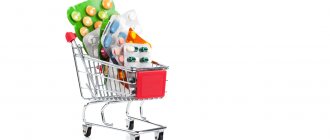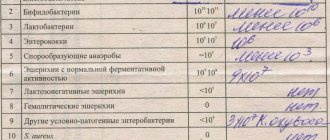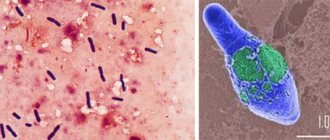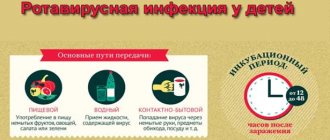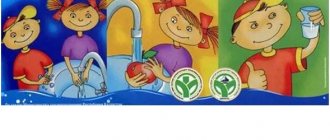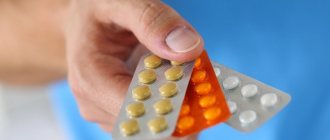The text is for informational purposes only. We strongly urge you not to use diets, resort to any therapeutic menus or fasting without medical supervision. We recommend reading: “Why can’t you go on a diet on your own?”
A diet for intestinal infections is a prerequisite that must be followed for a speedy recovery of the body. Dietary nutrition when the intestines are damaged by pathogenic flora is a mandatory point in the treatment of the disease. With intestinal infections, the entire digestive system as a whole is affected. During diarrhea and vomiting, not only water is removed from the body, but also useful substances that it needs to maintain normal functioning.
These substances need to be replenished, but in such a way that the digestive organs are able to cope with the incoming volumes of food. In fact, diet for intestinal infection is the most important part of symptomatic therapy that cannot be ignored.
How to treat intestinal infections with diet?
Regardless of which pathogenic microorganism provoked the development of the disease, therapy should begin with a complete abstinence from food. This means that during the acute stage of the disease, an adult can only drink water or rehydration solutions.
If the disease is not too severe, then it is permissible to drink sweet black tea - no more than 1.2 liters per day. In this case, a person should drink about 2.5 liters of water per day or even more. It is possible to use rice broth, rosehip or blueberry infusion passed through a sieve. All these drinks, in addition to replenishing the excreted volumes of fluid, are sources of vitamins and nutrients that the body so needs. Blueberries and rice water have the ability to bind harmful substances and remove them from the body, which allows you to quickly cope with the infection.
On the first day of illness, you can drink drinks that reduce the urge to vomit. This can be a mint decoction or homemade lemonade. To do this, mash lemon in a glass, pour hot boiled water over it and leave for a quarter of an hour. Add a teaspoon of honey to the drink. This drink is offered to the patient every 20 minutes, 2 tablespoons. When the acute phase of the disease is completed, you can move on to eating foods, but taking into account certain features of their selection and preparation.
Reviews and results
Among patients who have suffered an acute intestinal infection, positive reviews of dietary nutrition and a belief in its necessity and effectiveness for a quick recovery predominate.
- “... 2 weeks ago in the morning, against the background of general well-being, the child developed severe watery diarrhea, and a little later - vomiting and a rise in temperature. The child became lethargic and a little lethargic. He categorically refused food. They called a doctor who diagnosed an acute intestinal infection: rotavirus gastroenteritis. Prescribed treatment. We immediately bought all the necessary drugs. They gave the child plenty to drink, forced her to drink saline solution every 15 minutes for rehydration, still mineral water, boiled water, rosehip infusion, herbal teas with chamomile and linden, and dried fruit compote. The next day, little by little they began to give me weak broth (chicken with vegetables) and thin rice porridge. A day later - in small quantities light mucous soups, a piece of chicken breast, fish. The child had no appetite for almost a week and only then did he become interested in food. I added boiled pureed vegetables, fermented milk products and grated cottage cheese to the diet. And even when the symptoms had almost disappeared, I, on the doctor’s advice, kept the child on a diet for another month.”
What diet is indicated for intestinal infections in adults?
If a person is admitted to a hospital, then he is prescribed dietary table No. 4. This is a therapeutic nutrition system that is designed in such a way that it does not burden the digestive system, but saturates the body with nutrients.
The goals of table number 4 are:
- Sparing the gastrointestinal tract. Moreover, the sparing will be both chemical and mechanical.
- Reducing the degree of the body's inflammatory response.
- Reducing fermentation and putrefactive processes in the intestines.
- Restoration of intestinal function, regeneration of its mucous membrane.
The menu is complete and balanced. It contains a sufficient amount of protein, and carbohydrates and fats are slightly reduced. During intestinal infections, it is necessary to somewhat limit the consumption of table salt.
All products are offered to the patient in a semi-liquid or liquid consistency. Dishes should be neither hot nor cold. Acceptable methods of processing food are boiling and steaming. Before serving, be sure to grind rough food or grind it in another way. A person eats 5-6 times a day.
The average daily calorie content is equal to 1980 kcal. Salt per day should not be consumed more than 10 g. After the patient feels better, he is transferred to diet No. 4B, which involves a daily increase in the energy value of dishes to 3000 kcal. In this case, the dishes can already be cooked in the oven and stewed. However, product bans remain similar.
Drink plenty of fluids
It is known that the main danger of food poisoning is sudden loss of fluid caused by diarrhea and vomiting. In addition, the body loses minerals and electrolytes important for metabolic processes. To restore balance, the doctor usually prescribes rehydron and drinking boiled water in large quantities. After you feel better, water can be replaced with fruit and berry infusions, mint or ginger infusion without sugar. It is advisable to temporarily exclude tea, coffee, cola and other drinks containing caffeine and acids from the diet. You can drink milk if there is no negative reaction of the body to this product.
Diet rules
In order for the patient to recover quickly, the following diet rules must be followed:
- Dishes should be easily digestible, they should not irritate the mucous membrane of the intestines and stomach, or burden the pancreas.
- Dishes can be boiled or steamed
- Before serving, the products are ground or pureed.
- The optimal food temperature is 33-36 °C.
- The optimal portion is 150-300 g, depending on the age and weight of the patient, as well as on his state of health.
Rotavirus infection
The causative agent of intestinal infection can be different organisms. One of the most common pathogens is rotavirus. People also call it “intestinal” or “stomach flu”. With all the ensuing symptoms: vomiting or diarrhea. Most often it affects children, but adults can also catch the “stomach flu”.
The incubation period for the development of intestinal infection in adults ranges from several hours to several days. The illness can last up to two weeks. In adults, as a rule, the symptoms are not so pronounced; the disease can occur without fever, but they are very unpleasant.
Diet for intestinal infections in children
The general principles of feeding a child during intestinal infections are similar to the principles by which an adult patient eats. However, you must take into account the age of the baby.
During illness, children are no longer given dairy products, although in normal times they should always be on the menu. The fact is that milk contains milk sugar - lactose. Its breakdown and digestion occurs in the small intestine, the functioning of which is disrupted. With a bacterial infection, milk sugar will begin to ferment in the intestines, which will provoke increased gas formation, bloating and painful attacks.
If a child of the first year is exposed to an intestinal infection and is bottle-fed, the usual milk formula must be replaced with a lactose-free formula.
If a woman is breastfeeding, then you can slightly limit it in milk, but not more than 40%. It contains antibodies that help the baby’s body cope with the disease. At the same time, you need to breastfeed your baby more often, but in small portions. You should not force your baby to suckle; you need to focus on his appetite.
If the child has already reached the age when milk or formula is not the basis of his diet, then he should follow the same diet as an adult patient with an intestinal infection.
Indicative menu for a child with an intestinal infection:
- Semolina or semi-liquid rice porridge with water. Rice grains should be pureed. A glass of sweet tea and a cracker made from wheat flour.
- During the break between breakfast and lunch, the patient is offered a glass of jelly and a cracker.
- For lunch, the child can eat beef broth, crackers and meat soufflé. Supplement lunch with a glass of rosehip infusion.
- Blackcurrant jelly is eaten during afternoon tea.
- Dinner can be represented by grated oatmeal and a steamed chicken cutlet. Before going to bed, it is good to drink a glass of apple compote.
General rules
Intestinal infections (II) are represented by a large group of diseases with a fecal-oral mechanism of infection, caused by various pathogens ( salmonella , clostridia , shigella , rota- , adeno- , enteroviruses , amoeba dysentery , giardia , proteus and others), the common feature of which is the presence of diarrhea (diarrhea). In the structure of infectious morbidity in childhood, intestinal infections occupy a leading place. Regardless of the pathogen, the main manifestations of the disease are:
- The presence of gastroenteritis (acute inflammation of the stomach and small intestine) or enterocolitis (inflammation of the small and large intestines) or colitis (inflammation of the colon). The predominant damage to one or another part of the intestine depends on the specific disease.
- Dehydration of varying degrees caused by loss of fluid and minerals (sodium/potassium) due to frequent diarrhea and vomiting.
- The presence of general intoxication syndrome of varying severity, caused by the action of microorganisms and their metabolic products.
The goal of complex treatment is directly determined by the phase of the disease:
- In the acute period, treatment is aimed at combating the pathogen, removing toxic waste products of the infectious agent from the body, and relieving the intoxication syndrome.
- During the recovery period - restoration of impaired gastrointestinal functions.
An important component of the complex treatment of intestinal infections is properly organized therapeutic nutrition. The diet for intestinal infections in children is aimed at reducing the inflammatory process in the gastrointestinal tract, reducing intoxication, restoring water-salt metabolism, eliminating gastrointestinal dysfunction, and normalizing intestinal biocenosis.
Modern approaches to organizing nutrition for children with acute intestinal infection at any severity of the disease involve abandoning the previously widely practiced fasting water-tea break on the first day of the disease, since its administration contributes to malnutrition and the development of a deficiency of the protein component, slowing down the processes of repair of the gastrointestinal mucosa and reducing protective function of the body.
Diet for intestinal infection for children of the first year of life
For acute intestinal infections in children of the first year of life who are breastfed, breast milk is the optimal food product, since it contains anti-infective factors such as interferon , immunoglobulin A , lactoferrin , lysozyme . Lactation allows you to minimize the deficiency of nutrients in the child’s body, in particular protein, electrolytes, fluids, and helps restore the gastrointestinal mucosa. A free feeding schedule during the building phase is unacceptable, since putting a baby to the breast haphazardly leads to the occurrence/intensification of regurgitation, vomiting, and diarrhea .
It is important to have a night feeding break of at least 6 hours when feeding a child 8-10 times. The volume of milk per feeding on an 8-fold schedule (every 2 hours) should be 40-50 ml and 60-80 ml when feeding every 2.5 hours. with 6 feedings (after 3.5 hours) - 120-160 ml. In mild forms of the disease in children under one year of age, in the first 3-4 days from the onset of the disease, the diet is reduced by 15-20%. The missing volume to the physiological norm of nutrition is replaced with liquid (mainly special solutions - Regidron , Glucosolan ).
If there is a lack of breast milk, adapted infant milk/fermented milk formulas are used. It is prohibited to include unadapted milk formulas, kefir and whole milk in the diet of infants with acute intestinal infections due to the high risk of increased osmotic diarrhea and sensitization to cow's milk protein.
Children under six months old with mixed feeding and with positive dynamics in the gastrointestinal tract can be introduced to complementary foods already on the third day. Most often, 5% rice, buckwheat and semolina porridges are recommended for this purpose, which, if well tolerated, are replaced with 10% prepared with whole milk. The amount of complementary foods varies depending on the age of the child. After a few days, 10-20 g of cottage cheese, vegetable purees, jelly based on berries and fruits in an amount of 50-150 ml, and juices are added to the porridge. The diet is then expanded to include minced meat and other types of complementary foods.
For children with mild forms of acute intestinal infections who are bottle-fed, their diet includes adapted fermented milk mixtures “NAN fermented milk” and “Agusha 1” mixtures. Children 8-12 months old can also be given partially adapted fermented milk mixtures - acidophilic mixture “Malyutka”, “Agusha 2”, “NAN 6-12”. The diet of children of this age is more varied - porridge with added butter, cottage cheese, vegetable purees, 1/2 a chicken egg yolk, not concentrated broth, vegetable soup and minced meat.
If ACI is accompanied by symptoms of fermentative dyspepsia and flatulence, it is necessary to exclude sweet milk formulas and juices from the diet, replacing them with low-lactose/lactose-free infant formulas and food products, as well as formulas made from soy protein. It is recommended to give your child porridge with water (vegetable broth) without sugar, baked apples (up to 100 g per day), and three-day kefir.
It should be taken into account that in severe forms of intestinal infections, already in the acute period, especially in premature infants and with the presence of malnutrition, as well as in cases of invasive diarrhea, protein deficiency may occur due to a violation of the absorption process and loss of amino acids through the intestines. Such children, starting from the 3rd day of illness, are prescribed adapted milk formulas enriched with protein, intended for feeding premature babies, as well as cottage cheese.
Diet for children after one year and older age groups (from 3 years or more).
The nutrition of children in this age group is based on the same principles. On the first fasting day, kefir is prescribed after 3-3.5 hours, 150-200 ml, depending on age. It is important to take into account that the duration of the fasting period should not exceed 3-5 days, after which the single volume of food and the diet as a whole should be increased, and provide physiologically complete nutrition, taking into account the age norm and the functional state of the gastrointestinal tract, with the exclusion of prohibited foods from the diet.
The child's diet should include non-concentrated soups, kefir, dietary meat and lean fish, cottage cheese, butter, cream, chicken eggs, potatoes, and boiled vegetables. Cereals and vegetables for porridge and side dishes are well boiled until soft. Rice porridge in semi-liquid form is very useful, cooked in water without salt, butter and sugar, which has a good binding and enveloping effect on the mucous membrane. During the acute period of the disease, all dishes should be steamed/boiled and pureed or pureed (mashed porridge, pureed soups, omelettes).
Compotes made from dried fruits, jelly from berries, especially blueberries, lemons, and watermelons are useful. Products that enhance peristalsis, promote the development of fermentation processes, and also those containing coarse fiber (rye bread, legumes, cucumbers, all types of cabbage, beets, pasta, turnips, bananas, grapes) are excluded from the diet.
To reduce vomiting, food and liquid must be given at short intervals in small portions. Restrictions are prescribed until the frequency and nature of stools are normalized, after which the range of products is gradually expanded. If there is no appetite on the first day, it is prohibited to force-feed the child. During this period, it is important to provide the child’s body with a sufficient amount of fluid for its age.
As a free liquid, you can use herbal teas based on sage, chamomile, linden, pure boiled water, weak green tea, rosehip decoction, dried fruit compote, still mineral waters. In this case, the temperature of the liquid should approximately correspond to body temperature.
With a more pronounced degree of dehydration of the body, in order to replenish the volume of water and salts lost through vomiting and diarrhea, the child must necessarily receive saline solutions for rehydration - Regidron , Glucosolan , Gastrolit , Reosolan , Humana Electrolyte , Orasan , Gidrovit , which are sold in powder form, diluted boiled drinking water and drink.
The amount of free fluid that needs to be drunk during an intestinal infection is determined from the ratio of 80-100 ml of fluid after each episode of diarrhea/vomiting for children under 2 years of age and 150-200 ml of fluid/rehydration solution for older children. In this case, the entire volume of the solution must be consumed fractionally, in small sips of 50-100 ml every 5-10 minutes.
The child’s nutrition after an acute period of ACI is expanded. You can include in your diet boiled fish, meatballs, eggs, porridge with milk, steamed cutlets, soups in low-fat broth diluted with water, bananas, fresh apples without peel, white crackers, dry cookies, biscuits. Be sure to include enriched fermented milk products (with the addition of pro- and prebiotics ) in your diet. It should be taken into account that during the period of illness there is an increased breakdown of protein, so the diet should contain sufficient quantities of foods containing animal protein (chicken, beef, fish, cheese, cottage cheese, eggs).
Exclude from the diet fatty red meat (pork, lamb), animal fats, salmon fish, waterfowl meat (ducks/geese), which contains poorly digestible and difficult to digest fats. Easily digestible fats (including vegetable oils) should be consumed in small quantities. You should limit your intake of easily digestible carbohydrates in the form of sweets, sugar, pastries, cakes, ice cream, and canned juices, as they enhance fermentation processes in the intestines.
At the recovery stage, the diet for children after an intestinal infection should last at least 3-4 weeks, and in severe forms of the disease, up to 2-3 months. Ignoring the diet during this period can lead to the resumption of intestinal disorders and the formation of chronic enteritis or colitis . The diet is especially relevant after suffering from dysentery , rotavirus gastroenteritis , salmonellosis , in which insufficiency of the motor, evacuation and digestive functions of the intestine persists for a long period.
Therefore, a child’s diet after intestinal infections should exclude large meals, fatty and indigestible foods, as well as those containing coarse plant fiber and food additives (dyes, flavor enhancers, preservatives). The food menu for both younger and relatively older children should be moderately gentle with the exception of aggressive foods - smoked meats, fatty meats and fish, fried foods, sour foods, legumes, marinades, confectionery, ice cream, drinks containing alcohol and carbon dioxide , products that contain a high content of essential oils (onions, garlic, spices, radishes, radishes, coffee, chocolate). Just as with an intestinal infection in adults, it is necessary to take vitamin-mineral complex tablets intended for children.
What can you eat during intestinal infections?
The menu should include the following products and dishes:
- Bread made from wheat flour, but not fresh, but yesterday’s bread, slightly dried. Dry cookies, inconvenient pastries.
- Soups with weak fish or meat broth. Vegetables should be finely chopped, meat should be ground. You can make soup with meatballs, croutons or noodles.
- Meat is served in the form of souffles, cutlets, meatballs, and minced meat rolls. This can be lean varieties of red meat, rabbit, chicken, turkey. You can make pate from meat.
- Porridge should be viscous. They are boiled in water, without adding milk.
- The menu may include soft-boiled eggs, steam omelet, and noodles.
- Boiled buckwheat and rice, boiled potatoes, pumpkin, and carrots are used as a side dish. You can make puree, stew or caviar from vegetables.
- You can eat curd puddings, fresh cottage cheese, curd paste.
- You can drink 100 ml of kefir twice a day.
- You can add a small amount of butter to dishes or on bread.
- Jelly, decoctions of dried fruits, and rosehip decoction are allowed.
- You can drink tea with marmalade, honey or jam.
If the body does not give a negative reaction, then the patient’s menu can include fresh tomatoes (it is important that they are ripe), cauliflower, carrots, baked apples, raspberries, blueberries, and strawberries. You can put a little sour cream in soups. In this case, it is necessary to carefully monitor the patient’s well-being and, if it worsens, return to the original dietary menu.
Therapeutic nutrition for enteritis. Example menu
Approximate one-day menu: for the whole day - white bread - 400 g, sugar - 50 g (can be replaced with jam, marshmallows, marshmallows, marmalade).
- First breakfast: rice porridge on water with the addition of 1/3 milk, butter (5 g) - 300 g; fresh, unleavened cottage cheese - 100 g with sour cream - 10-15 g and sugar, tea 1 glass.
- Second breakfast: boiled chicken with rice, egg white omelet, tea, bread.
- Lunch: meat broth soup with noodles – 1 plate, steam cutlets – 125 g, carrot puree from boiled carrots – 150 g, apple jelly – 1 glass.
- Dinner: boiled fish, mashed potatoes - 150 g, savory bun, mild cheese - 25 g, tea - 1 glass.
- At night: non-sour kefir - 1 glass with white bread (or 1 glass of tea with dry biscuits (biscuits, dried biscuits, bread).
Therapeutic nutrition helps improve the general condition of the body, normalizes metabolism, improves the functional state of the intestines and other digestive organs, and recovery.
Nutritional therapy for diseases of the small intestine is mandatory and one of the main components of treatment. It should be used in combination with other therapeutic agents.
What should you not eat during intestinal infections?
The following foods and dishes should be excluded from the menu:
- Brown bread and fresh bread made from wheat flour.
- All raw vegetables and fruits, as they are sources of rough dietary fiber. His intestines will not be able to digest it.
- Mushrooms and fresh herbs.
- Pearl barley, millet and corn grits.
- Salt limit – up to 10 g per day.
- Vegetable oil.
- Carbonated drinks.
- Meat, vegetable and fish broths of high concentration.
- Sausage, smoked products, animal fats.
- Fatty red meat, fatty poultry (duck, goose). Chicken eggs should not be eaten fried or boiled.
- Preserved products.
- Whole milk, spicy cheese.
- Cream, pastry cream, sour cream.
- Legumes in any form, white cabbage.
- Dumplings and dumplings.
- Sauces.
- Strong coffee, carbonated drinks, chocolate, alcoholic drinks.
- Ice cream.
Food poisoning: is a doctor necessary?
Often food poisoning occurs in a fairly mild form, and most of us do not consider it necessary to visit a doctor, much less call an ambulance. But if the symptoms indicate a severe form of poisoning, medical help can be a matter of life or death. You should definitely visit a doctor if you or a loved one has:
- symptoms of severe dehydration: dizziness, dry mouth, rare and weak urination;
- diarrhea lasting three days or longer;
- blood in stool;
- high body temperature (above 38.5°C).
The presence of at least one of these signs may indicate critical changes in the condition. To return a person to normal, emergency measures may be needed - intravenous fluid administration, the prescription of strong antibiotic medications, etc. In this case, you should immediately go to see a doctor or call an ambulance if the patient’s condition does not allow him to get to the clinic on his own.
Norovirus infection
Norfolk virus spreads more often in winter, causing outbreaks of noravirus infection. Its incubation period lasts from several hours to two days, and occurs mainly in adults.
It manifests itself as high fever, aching muscles and joints, severe malaise, decreased appetite, rare vomiting and frequent diarrhea. Aching pain in the pit of the stomach and navel is also typical. Frequent diarrhea can lead to dehydration, which causes dry skin and mucous membranes, decreased urine volume, headache and severe weakness.
Good to know
First aid kit for the country: a list of medications for children and adults
Diarrhea - mechanism and causes of trouble
The cause of diarrhea in a baby can be food poisoning or an intestinal infection.
Diarrhea is a disruption of the processes of absorption and excretion of fluid in the intestines. Diarrhea is considered a consequence and a sign of various diseases, but not an independent illness. Causes of diarrhea:
- Rotavirus infection
- Intestinal infections
- Dysbacteriosis
- Colitis – inflammatory and dystrophic diseases of the intestine
- Crohn's disease
- Side effects of drugs
- Food poisoning
Symptoms of diarrhea depend on the cause of the disease, but the general signs are the same:
- Frequent bowel movements up to 10 or more times a day
- Dehydration
- Nausea
- Vomit
- Epigastric pain
- Weakness
- General intoxication of the body
If the baby has a long-term stomach upset, then you need to analyze the baby’s diet and carefully re-read the instructions for medications. If diarrhea does not subside within 24 hours and other symptoms appear, then the baby should be shown to a doctor.
Diarrhea in a toddler up to a year old, how to feed the baby?
If you have diarrhea in infants, you need to reduce food portions, but eat more often.
For babies under one year of age, it was also previously advised to go a day or 2 without food. But doctors abandoned this practice. Toddlers of this age do not have enough resources of their own to safely starve. The child may begin to lose weight due to muscle mass.
This negatively affects the condition of the little sufferer. The duration of recovery of the gastric mucosa increases. Doctors recommend continuing breastfeeding if you have diarrhea. But only if there is no vomiting and in small portions. To do this, apply the baby to the breast for 5 minutes, but do this more often than usual.
Diarrhea and diet in children, general rules
You need to feed your baby in small portions, but often.
Doctors have developed general rules of nutrition for diarrhea. They are used depending on the cause of the disease and the age of the patient:
- Avoid dehydration and salt imbalance
- Eat small portions, but often
- Food – light, non-spicy, gentle, heat- and mechanically processed
- Age gradation – nutrition should correspond to the patient’s age
Do not insist or force him to eat. As soon as the baby, and even the adult, begins to feel hungry, it means that things are getting better. And what the baby lost during the forced fast, he will quickly gain back after recovery.




